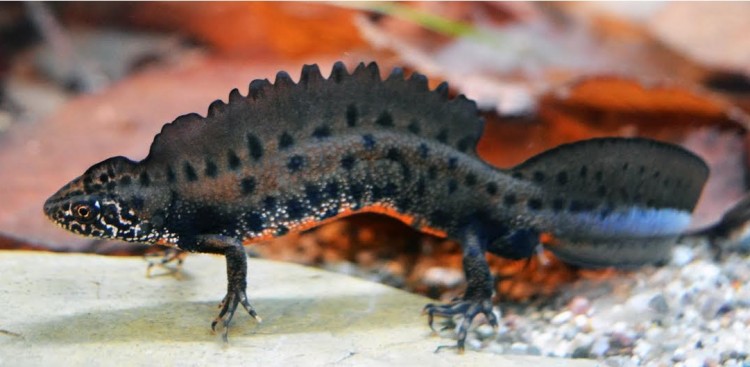
The assessment of distribution and conservation status of the Pannonian crested newt, (Triturus dobrogicus macrosoma) in Bosnia and Herzegovina is a preliminary conservation project with the main goal to describe some biological characteristics (distribution, morphology, ecology), which are unknown in this region for this species. Species has a lack of data and its conservation status can not yet be assessed with confidence, while there are assumptions that it is an endangered (EN) species and it is a high priority species for conservation actions in B&H...
Danube Crested Newt (Triturus dobrogicus) inhabits lowland areas (up to 250 m a.s.l.), flood river valleys and river systems of Southeastern Europe. In particular, species is widespread in lowland parts of the valley of the Danube river system. Those lowland areas are surrounded by mountain systems which are inhabited by other species of large crested newts (Triturus carnifex, T. macedonicus, T. cristatus and others). In the contact zone of mountainous and lowland regions hybridization takes place between the T. dobrogicus and and other mentioned crested newts.
Distribution of Danubae crested newt is divided into two main areal. Between them there is a natural and artificial barrier (Iron Gate) that separates described two subspecies: T. d. dobrogicus and T. d. macrosoma. However genetic analysis don't support subspecies recognition and T. dobrogicus should be considered nominotypic species like all other species of the genus Triturus.
In Bosnia and Herzegovina Danubae crested newt is a very rare species and can be found only in the northern parts of the territory along the valley of the Sava river (a tributary of the Danube). This area, known also as the Bosnian Posavina, represents the southwestern border of Danube Newt distribution.
Since the exploration of the Danube newt in Bosnia and Herzegovina is insufficient, it is necessary to explore new locations and describe habitats inhabited by this species. Therefore, the main objective is to assess the distribution and conservation status of this speceis in Bosnia and Herzegovina. Other objectives include taking the morphological characteristics of the captured individuals and taking DNA samples for future genetic analysis that will show the (non)existence of hybrid zones with other speceis of Crested newts (T. carnifex and T. macedonicus). In addition to research, one of the main goal is to educate young people and the local community with this, so far unknown, resource and introduce them to the need of protection, and preliminary establishment system for ex-situ conservation.
Given the fact that there is no biological data for large Crested Newts (genus Triturus) in Bosnia and Herzegovina, we actively search the entire area of northern Bosnia. This research area is divided into three field regions: western (Bosanska Krajina and Posavina), central Bosnian Posavina and eastern Bosnian Posavina (Semberija). In parts of the western region of the study we explore species Triturus carnifex, while in other parts of the investigating area we search Danubae Crested Newt - Triturus dobrogicus (species of interest).
The collected data also include taking the basic morphometric and environmental (ecological) parameters (humidity, temperature, pH, etc.). From every caught and measured individual we've taken DNA sample (from the end of the tail), so that can future genetic analyzes determined hybrid zone areal between the Triturus species in B&H (dobrogicus / macednoicus; dobrogicus / carnifex).
According to the IUCN Danube newt is NT: Near Threatened and very close to VU: Vulnerable. It is protected by the Bern Convention (Appendix II, a strictly protected species) and the European (Habitat) Directive on the protection of habitats and species. In Croatia and Serbia speceis is also considered as NT, while in Bosnia and Herzegovina is considered as a taxon without enough data (DD: Data Deficient), assuming that it is an endangered species (EN - Endangered). Assessment of the vulnerability according to the DELH (Distribution, Ecology, Life History Data) at the level of Bosnia and Hercegovina also suggest that it is an endangered species (EN), and it is a high-priority species for consevation action in Bosnia and Herzegovina. It has no CITES status.
Areas inhabited by Danubae crested newt (lowlands areas) are the most influenced by anthropogenic impacts in Europe. Since the Danube newt inhabits areas that are generally of agricultural and fishing significance of the man, suitable habitat for this species are on rapid change towards disappearing. The main factors of endangerment and extinction of this species are the loss or destruction of habitat through: (1) the expansion of arable land and draining water bodies (because speceis use temporary pools that dry out quickly), (2) use chemicals (such as pesticides that cause high mortality) and (3) fish stocking pfwater bodies in which the newts reproduce (because the fish feed on their eggs and larvae).
In the European Union it is illegal to hunt and possess the Danube newt. It is forbidden to kill or harm individuals of this speceis or the area in which they live. Unfortunately, the Danube newt in Bosnia and Herzegovina is not protected by law, and in Bosanska Posavina currently there are no protected areas. Special Nature Reserve Gromiželj (8 km2) has lost its status of protection in this year (2016), where now we have a situation that is out of control with uncontrolled deforestation of the Black Alder (Alnus glutinosa), soil and water pollution variety of waste materials, and the exploitation of animal resources through hunting and fishing. Likewise, the Ramsar site Bardača (lake complex situated between the rivers Sava and Vrbas) almost does not exists because 9 (of 11) lakes has been dried up and turned into a private agricultural land.